The Jungfrau Region is one of the most popular tourist destinations in Switzerland. It is one that many people consider to be a must-see, and there is a very good reason for that. If there is ever a thing as “perfect scenery”, you can be sure that the Jungfrau region has it.
It is the perfect amalgamation of magnificent waterfalls, sunny valleys, impressive rock faces, and snow capped mountain peaks. These naturally wonderful sightings come with the convenience of a wide range of hotels, resorts, and lodgings to spend your exciting vacation at.
Interlaken, Grindelwald, Mürren etc. are the kind of places where taking a vacation any time of the year can reap big returns. Not only does it serve as the perfect ski spot in the winters, but it also offers a ton of summer activities for children and adults alike.
In this blog post, we will go through the mesmerizing details of the Jungfraujoch Region of Switzerland and all it has to offer.
About the Jungfrau Region
The Jungfrau Region connects the three towns of Grindelwald, Interlaken, and Lauterbrunnen to make sort of a triangle. It stretches out to the Jungfrau mountain range towards the south – a UNESCO World Heritage Site.
Standing at 4,158 meters, the Jungfrau mountain is the tallest of the three iconic peaks that grace the skyline:
- Eiger, Mönch, Jungfrau
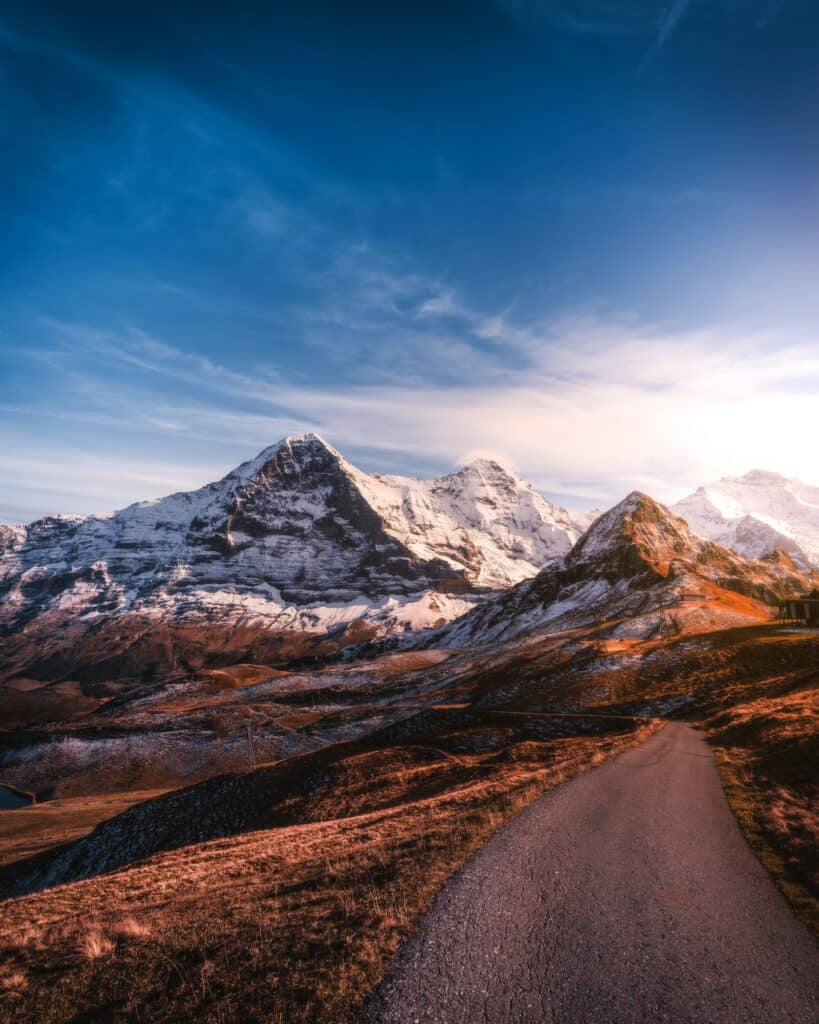
One of the primary reasons for this region’s popularity is its ski resorts during the winters, to which skiers and winter sports lovers from all over the world flock to. That, however, does not take away from the Jungfrau Regions beauty in the summers.
There are plenty of beautiful hiking trails in the surroundings to make Grindelwald, Lauterbrunnen and Interlaken some of the best towns to pay a visit to during the warmer months.
The car-free villages of Wengen and Mürren serve as the perfect places to wind down and take a relaxing breath as you enjoy the surrounding nature.
Jungfrau Region in Winter
During the winter months, the Jungfrau Region witnesses heavy snowfall and low temperatures that mostly tend to run below zero degrees Celsius.
Since it is mainly a ski region, it comes as no surprise that the winter months are some of the busiest here. Novice to expert skiers and snowboarders from all over the world make the trip to Jungfrau’s snow capped slopes to get a taste of adrenaline.
There are also locations for individuals looking to engage in sledging, winter hiking, ice skating, and snowshoeing.
There are a total of 260 km of ski runs in the ski areas around Wengen, Grindelwald, Mürren, and Hasliberg. These ski runs range all the way from leisurely to fast.
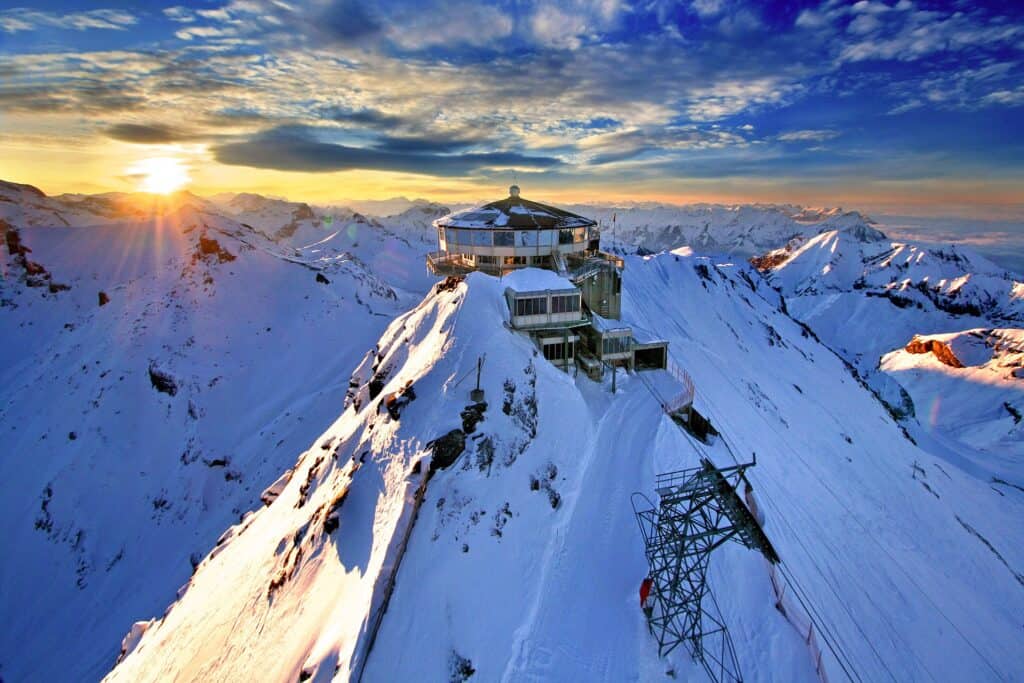
For non-skiers who still want to make the most of Switzerland’s winter, 100 km of winter footpaths are present in this area to help you explore the impressive mountains on foot.
Not to forget, of course, are the endless toboggan runs in the region, one of which is the world’s longest toboggan run, situated in the Alps.
Jungfrau Region in Summer
The weather in the Jungfrau area during the summer is pleasant. The higher mountainsides experience cooler temperatures and for example Jungfraujoch remains snowy pretty much all year round.
The town sides, though, are pleasantly warm for the most part. For hikers, the months of June, July, and August may make them break a sweat. Temperatures in these months can touch up to 24 degrees Celsius.
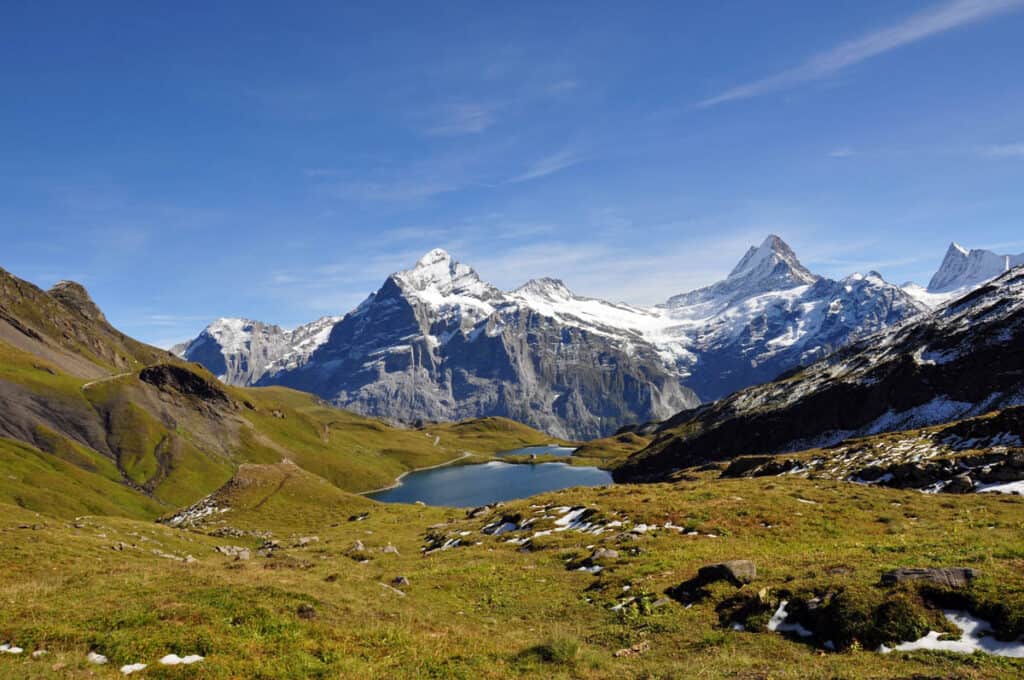
As the winter months come to an end, the Jungfrau Region experiences no shortage of activities to indulge in for holidaymakers. People make the journey from all corners of the world to the Jungfrau region for hiking and mountain excursions.
There is over 500 km of marked walking, mountain paths, and hiking trails to explore. From gushing waterfalls to crystal-blue lakes, what makes hiking in Jungfrau unique is the captivating scenery everywhere you look. Tourists get the added bonus of stunning views from the Mönch, Eiger, and Jungfrau as they walk across these trails.
If you are someone who likes their peace and quiet, Spring and Autumn (Fall) are the perfect seasons to pay a visit to Jungfrau.
Visitors of Spring get to experience the crisp blooming of the vibrantly colored wildflowers. Similarly, those arriving in the Fall will be greeted with the changing colors of nature as they get surrounded by the autumnal foliage.
Towns and Villages in the Jungfrau Region
Interlaken
The word “Interlaken” directly means “in between the lakes.” It is named so because the town of Interlaken is neatly nestled between two huge alpine lakes, called the Thunersee and Brienzersee.
It is located in the plains rather than the mountains. Despite its location, however, it still manages to provide some of the most remarkable views of Eiger, Mönch, and Jungfrau.
Compared to some of the surrounding towns and villages, Interlaken spans a larger area with a population of about 5,500 residents. This makes it a lively town with a lot to offer in terms of restaurants, shops, and hotels.
The biggest advantage of Interlaken is its central location. Conveniently situated at the gateway of a valley straight into the Alps, it takes only about 15 to 25 minutes from Interlaken to reach both Grindelwald and Lauterbrunnen. It also boasts two railway stations that make all nearby attractions easily reachable.
You can easily make a day trip to some parts of Switzerland from Interlaken and come back just in time. Therefore, if you plan to hit many different spots across the country, Interlaken is the perfect base to stay in.
Grindelwald
After Interlaken, one of the largest villages in the Jungfrau region is Grindelwald. Grindelwald can be reached both by car and train, making it a convenient location to visit and enjoy.
You might also like the following article:
Grindelwald’s location is not only convenient but supremely beautiful, thanks to the outstanding landscape surrounding every corner of the village.
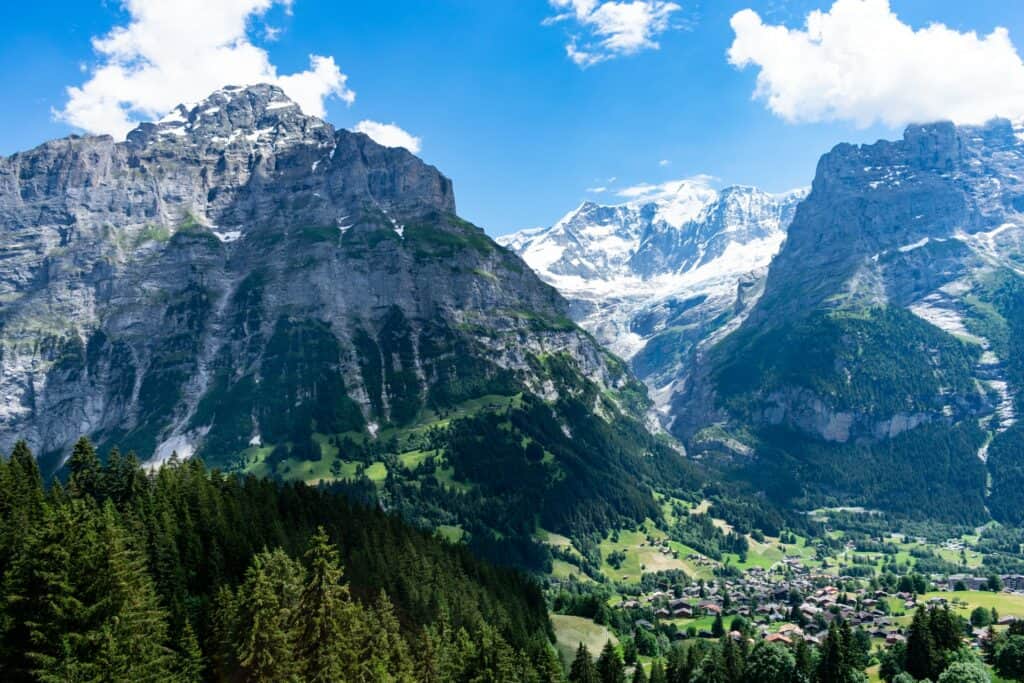
Rising nearly 3000 meters atop Grindelwald is the Eiger’s famous Nordwand (North Wall), dominating much of the view of the town. It is this and many other reasons that make Grindelwald a hub for tourists.
Apart from its stunningly eye-catching views, Grindelwald is a favorite tourist destination due to its practical infrastructure. Trains and cable cars are readily available to take you right into the heart of the mountains surrounding this quaint town. You can also easily access alpine valleys to the south of the town.
There is also a wonderful selection of hotels in Grindelwald as well as other types of lodgings, such as hostels and chalets.
Lauterbrunnen
Lauterbrunnen is one of the most beautiful valleys in Switzerland with its position right in the heart of the Alps. By itself, the Lauterbrunnen valley floor only stands at about 800 meters with 4,158 meters of Jungfrau stretching directly above it. This staggering 3358 meter (11’000 feet) difference and the huge rock walls that rise up hundreds of meters and surround the valley, both contribute to the impressive scenery. Some even call it the small Yosemite Valley of Switzerland.
You might also like the following article:
Nonetheless, it’s still one of those quintessential alpine villages in Switzerland that really hit the mark with its natural beauty and an abundance of activities for all types of visitors.

Surrounded by green fields, you will find numerous hotels, hostels, and apartments to make your visit comfortable while you are surrounded by the village’s many (72 in total!) waterfalls.
Even though the village is small in size you will find shops, restaurants and a small well-stocked supermarket and everything else you need for a pleasant stay in the Lauterbrunnen.
Wengen
Wengen is another one of Switzerland’s picturesque villages. No cars, beautiful mountain peaks and lush meadows surround the village. This makes Wengen the ultimate spot for the laid-back traveler who likes their serenity.
The location of Wengen is such that it gives charming views all the way from the depth of Lauterbrunnen up to the Jungfrau. During the summers, it is the perfect place to take a hike. During the winters, it has some of the best skiing and snowboarding opportunities to take advantage of.

Being a popular tourist destination, finding all the basic facilities, such as lodgings and transportation, is quite easy. This convenience, coupled with the no-car aspect, helps Wengen achieve a perfect balance and the best of both worlds.
Murren
Murren is a car-free village hanging nonchalantly on the edge of an 800m cliff, high above the Lauterbrunnen valley (on the opposite side of the valley to Wengen).
No matter where you go in Murren, you will be reminded of its stunning beauty. There are forests, green meadows and dramatic alpine landscapes all around you.
Traveling to the other parts of the Jungfrau Region can take a bit longer, therefore Mürren is the place to settle info if you want a peaceful holiday. But still, there are enough interesting options to have an active day.
Many hiking trails, including the Schilthorn peak (Piz Gloria), are easily accessible from Murren, making it the perfect summer spot.
The winters are no less adventurous in Murren as there are plenty of options for snowboarding, tobogganing, and skiing.
Gimmelwald
Gimmelwald is another small car-free village in the Bernese Oberland that is located between Stechelberg and Murren. It is at the foot of UNESCO’s World Heritage site of the Jungfrau-Aletsch Protected Area.
Often overlooked, Gimmelwald was first made famous by the famous Rick Steves many years ago. It’s a picture-perfect, tiny hidden gem that can be reached from Interlaken in a matter of 30 minutes by car or train. Gimmelwald is exactly what you would imagine if you were to picture the Alps in your head.
The quiet village is almoust tiny. However, it still has lodging options for those who want to spend a few quiet days a bit off the beaten tracks.
Things To Do
The iconic mountain landscape of the Jungfrau Region has world-famous waterfalls, enormous glaciers, and expansive meadows. All of these aspects combine to make the region one of the most unforgettable experiences for visitors.
Surrounded by the spellbinding alpine scenery, you will want to stay outdoors and take in the fresh mountain air 24/7. Luckily, the Jungfraujoch Region offers loads of opportunities for outdoor activities and adventurous sports, no matter what season it is. The area offers plenty of popular mountain excursions including Harder Kulm, Schilthorn, Schynige Platte and of course the world famous Jungfraujoch that you definitely will enjoy.
If you are visiting the area for a few days or more, consider purchasing the Jungfrau Travel Pass. The pass offers free and discounted travel on trains, funiculars, cableways, and boats.
Let’s have a look at some of the most exciting things you can do in the Jungfrau region.
Mountain Excursions
The Jungfrau region has many mountain excursions that allow visitors to delve deeper into the area and explore it further. Some of the most popular mountain excursions include:
- Harder Kulm: A mountain that looms over Interlaken, Harder Kulm gives you amazing views of the Bernese Alps and Eiger, Monch and Jungfrau. When you are staying in Interlaken it is the perfect place to start your vacations in the Bernese Oberland.
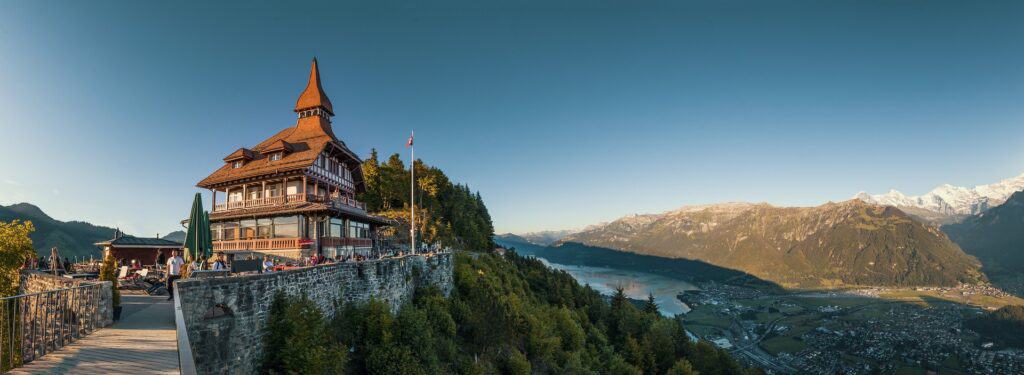
- Jungfraujoch: Your trip to the Jungfrau region would not be complete without a trip up to the Jungfraujoch. One of the most popular Swiss peaks, Jungfraujoch does definitely not disappoint. The railway track leads through the mountains of Eiger and Mönch up to the highest railway station of Europe, therefore the name “Top of Europe”. Take a walk through the ice cave, have fun in the snow, experience the stunning view of the Aletsch Glacier, or take a hike out to the Monchsjoch Hutte.
- Schilthorn: One of the highest peaks in the Jungfrau region, visitors of Schilthorn will find themselves surrounded by panoramic views of the Swiss Alps.
- Schynige Platte: You can easily get to Schynige Platte by taking the historic cogwheel train from Wilderwil. It takes about 52 minutes to reach Schynige Platte and along the way you will enjoy the beautiful views of Interlaken, Lake Brienz, and the Lauterbrunnen Valley.
For those who want to delve deeper into the Jungfrauregion and explore these mountain excursions, the Jungfrau Travel Pass (sometimes also called Jungfrau Region pass) will be a worthwhile purchase.
Hiking
There is no shortage of hikers in the area around Grindelwald and the rest of the region during the summer months. As the warmer season approaches and the snow bids us goodbye, many hiking trails are revealed. With trails suitable for all abilities, breathing in the fresh mountain air while the sun is shining down on us, hiking is one of the simple pleasures available to those visiting the Jungfrau Region.
One of the most popular hikes for tourists is the walk from Mannlichen to Kleine Scheidegg. This is an easy trail that is mostly directed downhill. As with any other trail in Jungfrau, these tracks also offer spectacular views, specifically those of Eiger, Monch, and Jungfrau.

For those who like a bit of a challenge, the Hardergrat Trail is the way to go. It is one of the most famous trails in Switzerland, and the fantastic views that surround this trail make its tough hike more than worth it. It is only recommended for those with ample hiking experience and a high level of physical fitness.
The Eiger Trail is another great opportunity to experience the Swiss landscape. This beautifully designed point-to-point trail comes with a spellbinding view of the Kleine Scheidegg, Lauberhorn, and Grindelwald. Since the trail is at the foot of the world-famous Eigernordwand you maybe even can spot a few climbing enthusiasts make their way to the top of this huge rock face wall.
Skiing and Snowsports
If you are visiting the area during the winters, there is a high chance that you are here to make the most of Jungfrau’s ever-abundant ski slopes. These slopes extend 260 km, providing skiers and snowboarders ample space to get their heart pumping.
Giving access to the mountains are the wide array of cableways and lifts that allow winter sports enthusiasts to reach the desired spot conveniently.
Other thrilling options available during the winters include sledging rides and snowshoeing tours that whisk tourists through the picturesque frozen Swiss winter.
The surrounding towns and villages should not be ignored during the winters as well. The towns of Interlaken and Grindelwald and the beautiful villages of Murren and Lauterbrunnen are other areas that allow visitors to get a taste of Switzerland’s undisturbed natural beauty.
Adrenaline sports
Jungfrau is the perfect place for those who want the ultimate adrenaline fix. While in the area, adventurous tourists can engage in fast-paced sports, such as bungee jumping and skydiving.
One of the more thrilling options is paragliding, which you can do in the Bernese Oberland. You will find many companies offering tandem paragliding for tourists that leave from Interlaken or Murren.
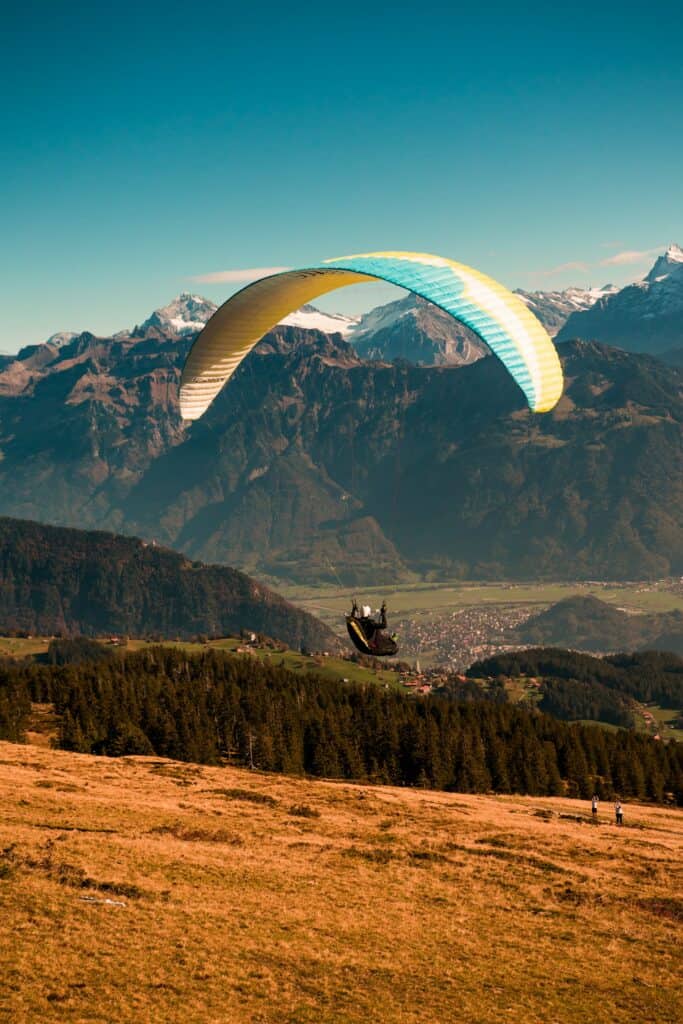
However, if you are someone who wants to go all out and experience one of Jungfrau’s biggest thrills, the Murren via ferrata will be perfect for you.
Murren via ferrata is a journey of 2.2 km 2000 feet above the ground. Half of the journey takes place through a ferrata while the other half is covered via a hiking trail. Way down below, views of a gushing river and the Lauterbrunnen Valley can be seen as you dangle above and make your way through, climbing steep ladders, walking on a tightrope and over suspension bridges.
How to Get to the Jungfrau Region
Switzerland’s state-of-the-art train network, decent roads, and a reliable transport infrastructure make reaching any part of the country convenient.
Getting to the Jungfrau region is quite easy, especially from major centers of the country, such as Zurich, Lucerne, and Bern.
By Train
- Zurich city and airport: Under 3 hours
- Bern: 45 minutes
- Lucerne: Under 2 hours
By Car
- Zurich: About 2 hours
- Berne: About 40 to 45 minutes
- Lucerne: Roughly 1 hour
Final Thoughts
If you want to see spectacular alpine views while you ride in historic railway cars, there simply is no better place than the Jungfraujoch area. The landscape boasts panoramas that you would be hard-pressed to find anywhere else in the world.
You can hike through the snow on the region’s many charming mountains, go zip lining, and even ride a train up to the highest train station in Europe. If all this sounds great to you, then a visit to the Jungfrau Region is something you simply can’t miss.
